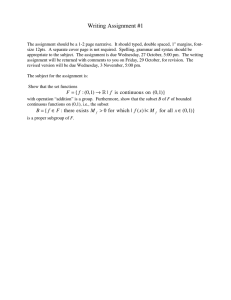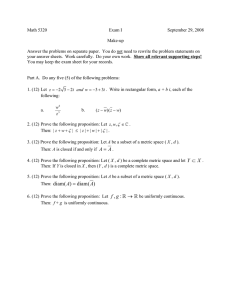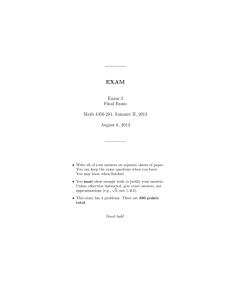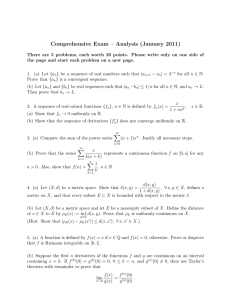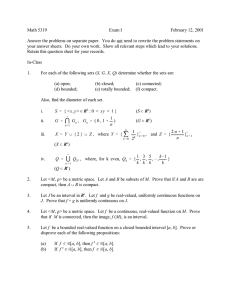Principles of Analysis I
advertisement
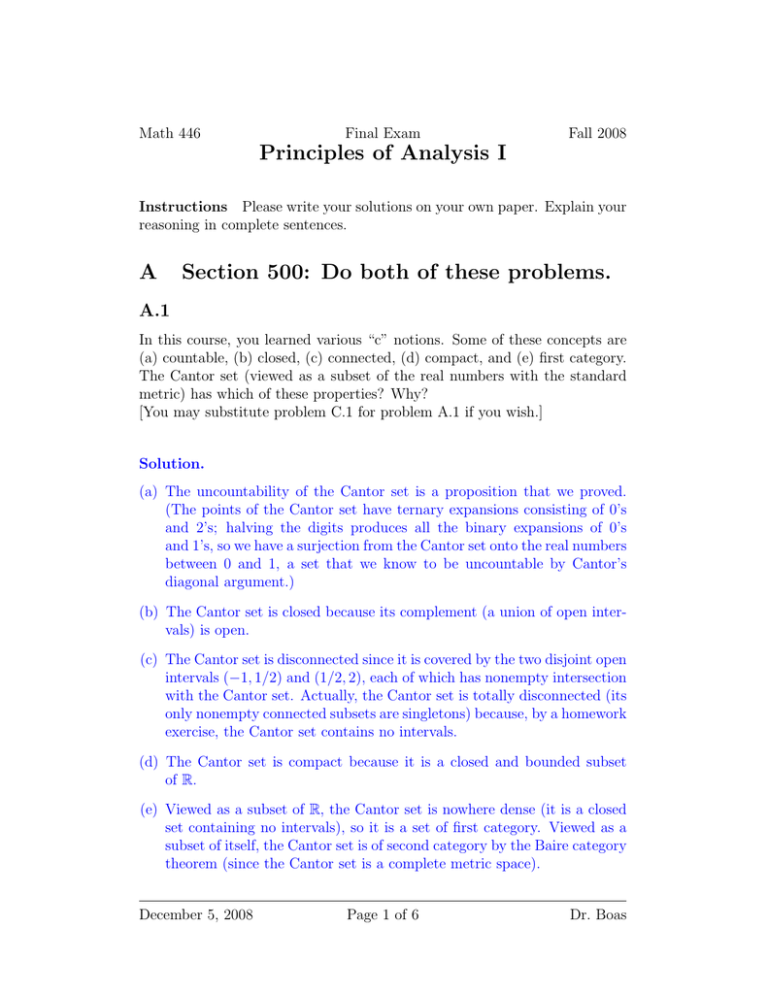
Math 446
Final Exam
Fall 2008
Principles of Analysis I
Instructions Please write your solutions on your own paper. Explain your
reasoning in complete sentences.
A
Section 500: Do both of these problems.
A.1
In this course, you learned various “c” notions. Some of these concepts are
(a) countable, (b) closed, (c) connected, (d) compact, and (e) first category.
The Cantor set (viewed as a subset of the real numbers with the standard
metric) has which of these properties? Why?
[You may substitute problem C.1 for problem A.1 if you wish.]
Solution.
(a) The uncountability of the Cantor set is a proposition that we proved.
(The points of the Cantor set have ternary expansions consisting of 0’s
and 2’s; halving the digits produces all the binary expansions of 0’s
and 1’s, so we have a surjection from the Cantor set onto the real numbers
between 0 and 1, a set that we know to be uncountable by Cantor’s
diagonal argument.)
(b) The Cantor set is closed because its complement (a union of open intervals) is open.
(c) The Cantor set is disconnected since it is covered by the two disjoint open
intervals (−1, 1/2) and (1/2, 2), each of which has nonempty intersection
with the Cantor set. Actually, the Cantor set is totally disconnected (its
only nonempty connected subsets are singletons) because, by a homework
exercise, the Cantor set contains no intervals.
(d) The Cantor set is compact because it is a closed and bounded subset
of R.
(e) Viewed as a subset of R, the Cantor set is nowhere dense (it is a closed
set containing no intervals), so it is a set of first category. Viewed as a
subset of itself, the Cantor set is of second category by the Baire category
theorem (since the Cantor set is a complete metric space).
December 5, 2008
Page 1 of 6
Dr. Boas
Math 446
Final Exam
Fall 2008
Principles of Analysis I
A.2
sin(x)
.
x
Is this continuous function uniformly continuous on the open interval (0, 1)?
Explain why or why not.
[You may substitute problem C.2 for problem A.2 if you wish.]
Consider the continuous function f : (0, 1) → R defined by f (x) =
Solution. The function is uniformly
continuouson the open interval (0, 1).
sin(x) sin(y) appears difficult, so you
−
Making a concrete estimate of x
y should try to apply some theorem.
One possibility is to compute the derivative f 0 (x) and show that it is
bounded. A function with a bounded derivative satisfies a Lipschitz condition
and hence is uniformly continuous.
A simpler method is to observe that limx→0 f (x) = 1, and limx→1 f (x) =
sin(1), so f extends to be a continuous function on the closed interval [0, 1].
We proved a theorem stating that a continuous function on a closed, bounded
interval is automatically uniformly continuous.
B
Section 500 and Section 200: Do two of
these problems.
B.1
xn
Suppose 0 ≤ x ≤ 1, and fn (x) =
when n is a positive integer. Discuss
1 + nx
convergence of the sequence (fn ) on the closed interval [0, 1]. (Does this
sequence of functions converge pointwise? uniformly? How do you know?)
Solution. Since 0 ≤ fn (x) ≤ xn , we see that fn (x) → 0 as n → ∞ if
0 ≤ x < 1. On the other hand, fn (1) = 1/(1 + n), so fn (1) → 0 too. Thus
the indicated sequence of functions converges pointwise to the 0 function.
One way to show that the convergence is actually uniform is to use a
“divide and conquer” method. Observe that
max |fn (x) − 0| ≤ max xn =
0≤x≤1/2
December 5, 2008
0≤x≤1/2
Page 2 of 6
1
,
2n
Dr. Boas
Math 446
Final Exam
Fall 2008
Principles of Analysis I
and
1
2
= .
1/2≤x≤1 nx
n
max |fn (x) − 0| ≤ max
1/2≤x≤1
Therefore max0≤x≤1 |fn (x) − 0| → 0 as n → ∞, so the convergence is uniform. (Indeed, if ε is an arbitrary positive number, and if n > 2/ε, then
max0≤x≤1 |fn (x) − 0| < ε.)
Alternatively, you could compute the derivative fn0 (x), observe that the
derivative is never negative when 0 ≤ x ≤ 1, and deduce that each fn (x) is an
increasing function of x. Therefore max0≤x≤1 |fn (x) − 0| = fn (1) = 1/(1 + n).
Since this maximum tends to 0 as n increases, the convergence of the sequence
of functions is uniform.
Since for each x the sequence (fn (x)) is monotonically decreasing as n increases, the uniformity of the convergence also follows from Dini’s theorem
(Exercise 18 on page 151 in the textbook), but I did not expect you to solve
the problem that way since we did not do that exercise.
B.2
In the metric space C[0, 1] of continuous real-valued functions on the closed
interval [0, 1], let S be the subset consisting of those continuous functions f
such that f (0) = 0 and |f (x) − f (y)| ≤ |x − y| for all x and y. Is the set S a
compact subset of C[0, 1]? Explain.
Solution. According to the Arzelà–Ascoli theorem, we will know that the
set S is a compact subset of C[0, 1] if we can check that the set S is (a) closed,
(b) pointwise bounded, and (c) uniformly equicontinuous.
That S is closed follows because the conditions defining S are preserved
under taking limits. More precisely, if (fn ) is a sequence in S converging to
some limit function f in C[0, 1], then |f (x)−f (y)| = limn→∞ |fn (x)−fn (y)| ≤
|x − y|, and f (0) = limn→∞ fn (0) = 0.
That S is pointwise bounded follows because if f ∈ S and x ∈ [0, 1], then
|f (x)| = |f (x) − f (0)| ≤ |x − 0| ≤ 1. Thus S is even uniformly bounded by 1.
That S is uniformly equicontinuous follows from the hypothesis that f satisfies a Lipschitz condition. Namely, if ε is an arbitrary positive number, we
can take δ equal to ε. Then if |x − y| < δ, it follows from the Lipschitz
condition that |f (x) − f (y)| < ε for every f in S. Since the same δ works for
December 5, 2008
Page 3 of 6
Dr. Boas
Math 446
Final Exam
Fall 2008
Principles of Analysis I
every f and for all x and y, the set S of functions is uniformly equicontinuous.
B.3
State the following three theorems: (a) the Bolzano–Weierstrass theorem for
real numbers, (b) Hölder’s inequality for sequences, and (c) the Weierstrass
approximation theorem (any version).
Solution.
(a) The Bolzano–Weierstrass theorem says that every bounded sequence of
real numbers has a convergent subsequence; or, equivalently, that every
bounded infinite subset of R has a limit point.
(b) Hölder’s inequality says that if p and q are real numbers greater
P∞ than 1
−1
−1
such that p + q = 1, if x ∈ `p , and if y ∈ `q , then j=1 |xj yj | ≤
kxkp kykq .
(c) The Weierstrass approximation theorem says that the polynomials are
dense in C[0, 1]; or, in its trigonometric version, that the trigonometric
polynomials are dense in C[0, 1].
B.4
Suppose (M, d) and (N, ρ) are homeomorphic metric spaces. If M is complete, must N be complete? If M is separable, must N be separable? Explain.
Solution. The answer to the first question is negative: take M to be the
complete metric space R and take N to be the incomplete metric space
(0, 1) (both with the standard metric). These spaces are homeomorphic [via
x 7→ (1/2) + π −1 arctan(x)].
The answer to the second question is affirmative. Recall that a metric
space is separable if it has a countable dense subset. A homeomorphism is,
in particular, a bijection, so a homeomorphism takes a countable set to a
countable set. Moreover, homeomorphisms preserve convergent sequences,
open sets, and closed sets, so homeomorphisms take dense sets to dense sets.
December 5, 2008
Page 4 of 6
Dr. Boas
Math 446
Final Exam
Fall 2008
Principles of Analysis I
C
Section 200: Do both of these problems.
C.1
In this course, you learned various “c” notions. Some of these concepts are
(a) countable, (b) closed, (c) connected, (d) compact, and (e) first category.
The set of sequences of 0’s and 1’s, viewed as a subset of the normed space `∞
of bounded sequences, has which of these properties? Why?
Solution. Call the indicated set S.
(a) The set S of sequences of 0’s and 1’s is equivalent to the set of real
numbers between 0 and 1, so S is an uncountable set.
(b) The set S is closed because the only convergent sequences of points
of S are eventually constant (because the distance between two distinct
elements of S equals 1). Hence S contains all its limit points.
(c) The set S is disconnected because there exists a continuous function
from S onto the two-point discrete space {0, 1}. Indeed, every function
from S into another metric space is continuous because all the points of S
are isolated. One example of a surjective function from S onto {0, 1} is
the function that takes the sequence (0, 0, 0, . . .) to 0 and every other
sequence to 1. In fact, the set S is totally disconnected.
(d) The set S is not compact because it is not totally bounded. An open
ball in `∞ of radius 1/3 contains at most one element of S, so no finite
number of such balls can cover S.
(e) The set S, viewed as a subset of `∞ , is nowhere dense (it is a closed set
that contains no open ball), so it is a set of first category. Viewed as a
subset of itself, the set S is a set of second category by the Baire category
theorem (since S is a complete metric space).
C.2
Let M be the metric space R2 \ {(0, 0)} (the “punctured plane”) equipped
with the standard metric inherited from R2 . Consider the continuous funcDecember 5, 2008
Page 5 of 6
Dr. Boas
Math 446
Final Exam
Fall 2008
Principles of Analysis I
x2 − y 2
. Is this function uniformly
x2 + y 2
continuous on M ? Explain why or why not.
tion f : M → R defined by f (x, y) =
Solution. We can see that f is not uniformly continuous by exhibiting two
sequences (pn ) and (qn ) in M such that kpn −qn k → 0 but |f (pn )−f (qn )| = 2
(for then the definition of uniform continuity cannot be satisfied with
√ ε equal
to 1). Take pn = (1/n, 0) and qn = (0, 1/n). Then kpn − qn k = 2/n → 0,
and f (pn ) − f (qn ) = 2.
D
Extra credit (optional) for both Section 500
and Section 200
For bonus points, prove either (a) the Bernstein equivalence theorem about
sets of the same cardinality or (b) the Baire category theorem for complete
metric spaces.
Solution. These proofs can be found in the textbook on pages 24 and
131–133.
December 5, 2008
Page 6 of 6
Dr. Boas

